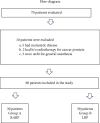A Randomized Controlled Study of Robot-Assisted versus 3D Laparoscopic Radical Prostatectomy in Patients with Carcinoma Prostate
- PMID: 37260587
- PMCID: PMC10229245
- DOI: 10.1155/2023/4666116
A Randomized Controlled Study of Robot-Assisted versus 3D Laparoscopic Radical Prostatectomy in Patients with Carcinoma Prostate
Abstract
Materials and methods: A prospective randomized comparative study was performed from 1st January 2020 to 30th June 2021. All patients included were diagnosed with localized/locally advanced ca prostate. 60 patients fulfilling the inclusion and exclusion criteria were randomized into 2 groups. Groups A and B included patients who underwent robot-assisted radical prostatectomy and 3D laparoscopic transperitoneal radical prostatectomy, respectively. Various demographic, intraoperative, postoperative, and follow-up parameters were collected. Outcomes were evaluated in the form of the trifecta (continence, potency, and BCR-free status) and pentafecta rates (trifecta with no perioperative complications and negative surgical margins) in between the two groups.
Results: The mean operative time in Group A was 137.83 mins ± 17.27 compared to 148.20 mins ± 26.16 in Group B. Trifecta rates in Group A and Group B were 43.3%, 63.3%, and 76.6% and 40%, 53.3%, and 70% at 1, 3, and 6 months. Pentafecta rates in Group A and Group B were 36.6%, 53.3%, and 70% and 33.3%, 40%, and 53.3% at 1, 3, and 6 months. Complication rates were 10% in Group A and 13.3% in Group B, respectively. Only one patient in our study (Group B) had a positive surgical margin.
Conclusions: We conclude from our comparative study, that both robot-assisted and 3D laparoscopic transperitoneal radical prostatectomy are feasible and efficacious treatment modalities for achieving acceptable trifecta and pentafecta rates in managing ca prostate with earlier continence and shorter urethrovesical anastomosis time in the robotic arm.
Copyright © 2023 Ketan Kumar Kapoor and Anup Kumar.
Conflict of interest statement
The authors declare that they have no conflicts of interest.
Figures
Similar articles
-
Pentafecta: a new concept for reporting outcomes of robot-assisted laparoscopic radical prostatectomy.Eur Urol. 2011 May;59(5):702-7. doi: 10.1016/j.eururo.2011.01.032. Epub 2011 Jan 25. Eur Urol. 2011. PMID: 21296482
-
3D vs 2D laparoscopic radical prostatectomy in organ-confined prostate cancer: comparison of operative data and pentafecta rates: a single cohort study.BMC Urol. 2015 Feb 21;15(1):12. doi: 10.1186/s12894-015-0006-9. BMC Urol. 2015. PMID: 25887253 Free PMC article. Clinical Trial.
-
Transperitoneal versus extraperitoneal robot-assisted laparoscopic radical prostatectomy: A prospective single surgeon randomized comparative study.Int J Urol. 2015 Oct;22(10):916-21. doi: 10.1111/iju.12854. Epub 2015 Jul 26. Int J Urol. 2015. PMID: 26212891 Clinical Trial.
-
[Transperitoneal versus extraperitoneal robot-assisted radical prostatectomy for localized prostate cancer].Zhonghua Nan Ke Xue. 2017 Jun;23(6):540-549. Zhonghua Nan Ke Xue. 2017. PMID: 29722948 Review. Chinese.
-
Retzius-sparing versus standard robotic-assisted laparoscopic prostatectomy for the treatment of clinically localized prostate cancer.Cochrane Database Syst Rev. 2020 Aug 18;8(8):CD013641. doi: 10.1002/14651858.CD013641.pub2. Cochrane Database Syst Rev. 2020. PMID: 32813279 Free PMC article.
Cited by
-
A comprehensive examination and meta-analysis evaluating perioperative, oncological, and functional results of robotic-assisted radical prostatectomy (RARP) in comparison to three-dimensional laparoscopic radical prostatectomy (3D LRP).J Robot Surg. 2024 Sep 30;18(1):356. doi: 10.1007/s11701-024-02110-6. J Robot Surg. 2024. PMID: 39347856
References
-
- Menon M., Tewari A., Peabody J. O., et al. Vattikuti Institute prostatectomy, a technique of robotic radical prostatectomy for management of localized carcinoma of the prostate: experience of over 1100 cases. Urologic Clinics of North America . 2004;31(4):701–717. doi: 10.1016/j.ucl.2004.06.011. - DOI - PubMed
-
- Dindo D., Demartines N., Clavien P.-A. Classification of surgical complications: a new proposal with evaluation in a cohort of 6336 patients and results of a survey. Annals of Surgery . 2004;240(2):205–213. doi: 10.1097/01.sla.0000133083.54934.ae. - DOI - PMC - PubMed
LinkOut - more resources
Full Text Sources





